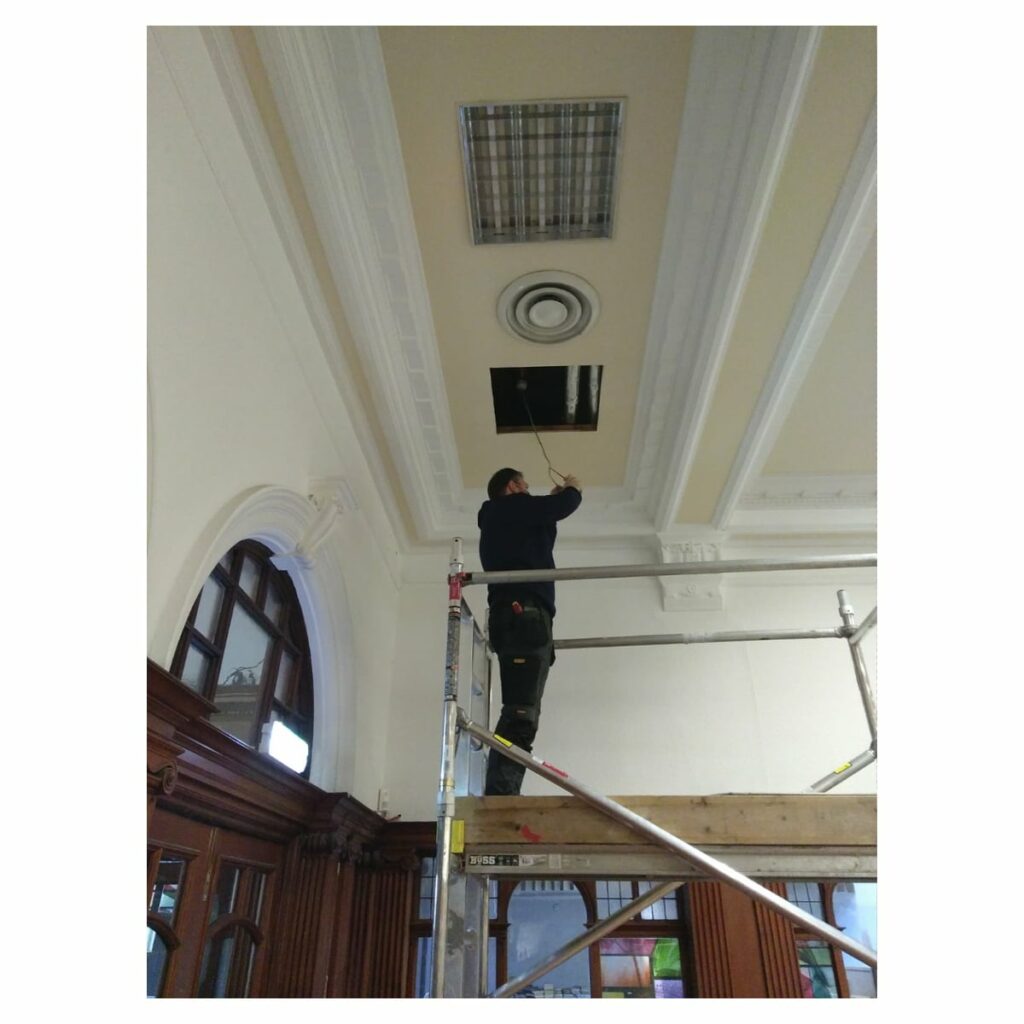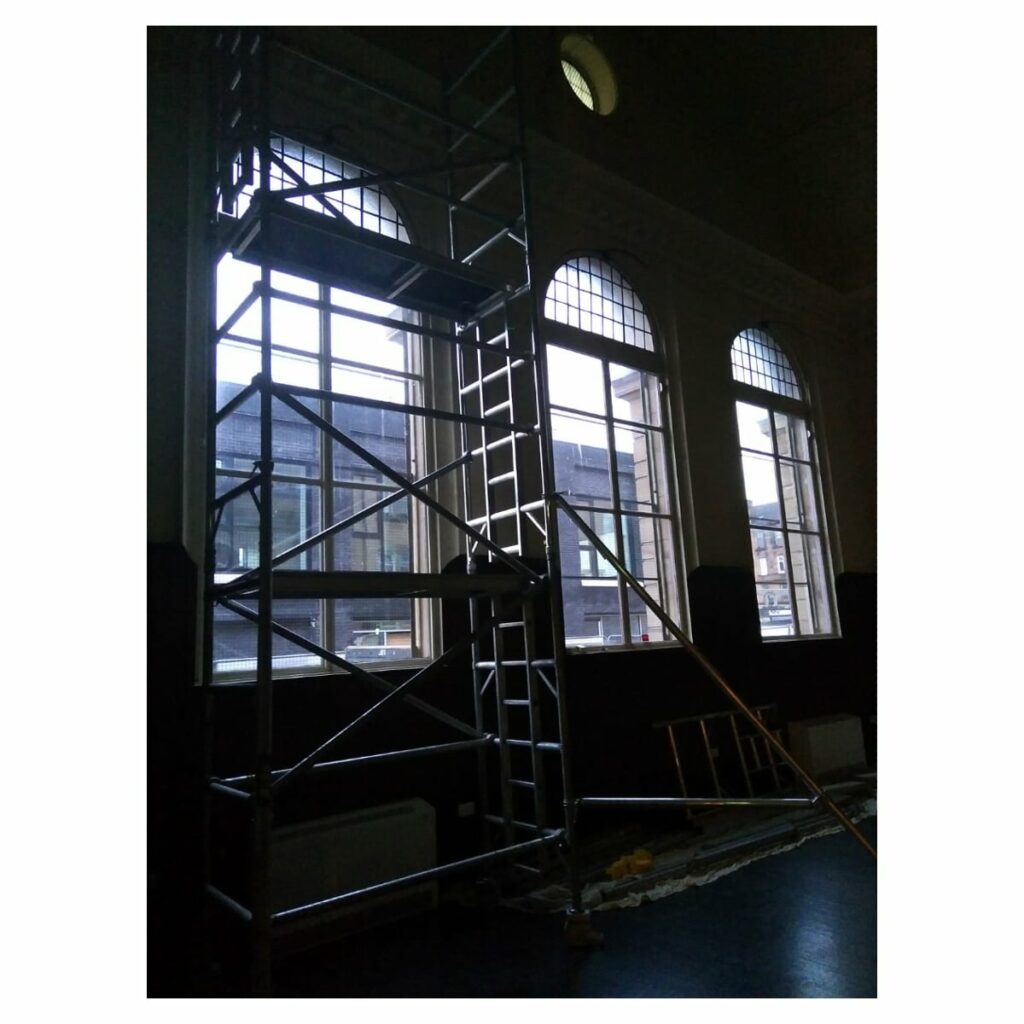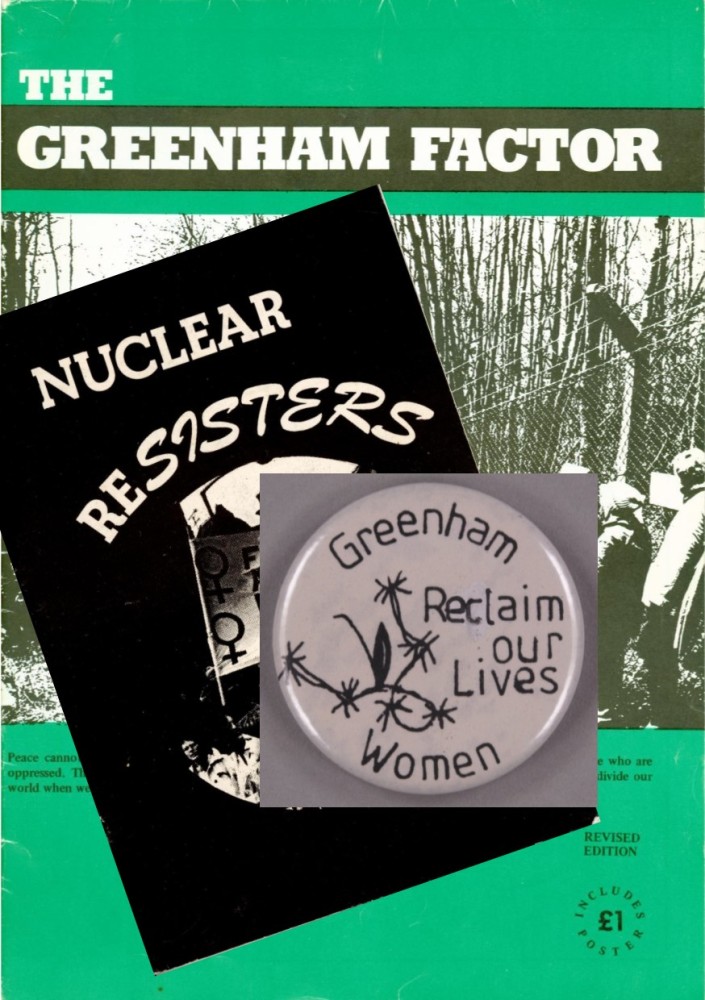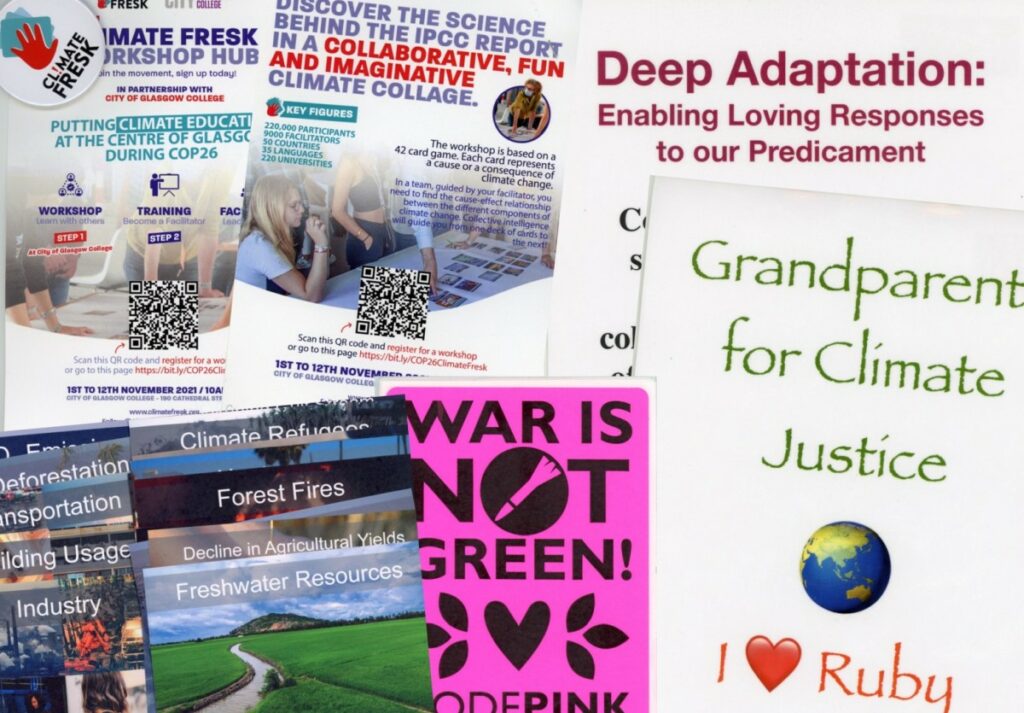Going Green at Glasgow Women’s Library
Category: Blog, CILIPSGoGreen
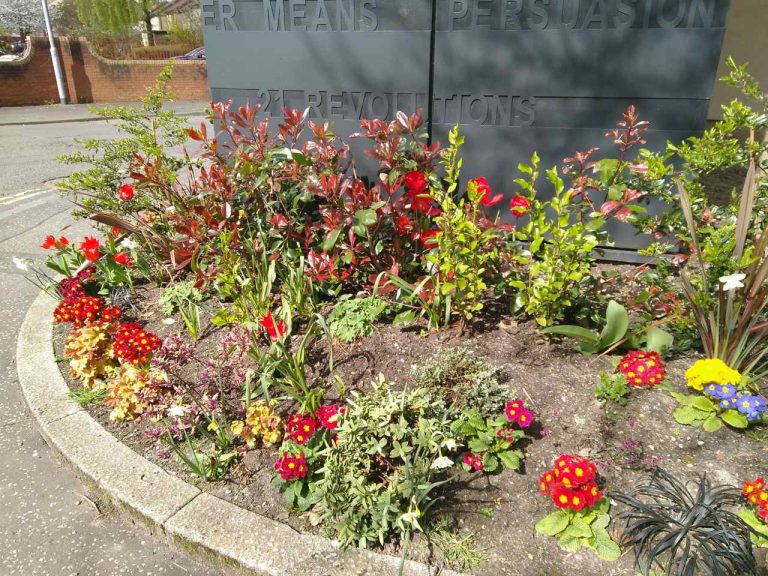
Written by GWL’s Green Creative Cluster: Gabrielle, Becca, Mary, Jenny and Caroline.
Since its grassroots inception in 1991, Glasgow Women’s Library (GWL) has considered its impact on the environment. From upcycling and recycling to gardening and allotmenteering, our organisation has sought to care for and connect with nature for over 30 years. You can read about some earlier projects here.
The urgency of the climate crisis has led to a ramping up of our ‘green’ activities in recent years. This work has been led by GWL’s Green Creative Cluster, a group of volunteers and staff from across the organisation, from facilities management to programming, collections and project delivery.
In this post we introduce some of the Green Cluster’s work, which focuses on our own environmental impact and on ensuring that women’s work in caring for the environment is documented, celebrated and shared.
Environmental impact: minimising the negative and maximising the positive
A key strand of the Green Cluster’s work is taking practical steps to minimise our negative impact on the environment and maximise the positive impact. Our objectives are to care for our environment and reduce our carbon emissions. Here, Mary and Becca talk about creating a garden and producing a Net Zero Handbook:
From tiny seeds: growing a garden
Four years ago we made a garden just outside GWL, transforming a litter-infested urban space into something really lovely. We have managed to fill the space with colour and interest all year long and it makes such a welcoming statement to all our visitors (see photo above). The garden is certainly something local people comment on and enjoy. There’s a bench and two shady plane trees nearby and we now have an outdoor space where we can relax and feel a bit more connected to nature.
Our patch of plants doesn’t only benefit people, it’s a link in an urban network for pollinator insects and for birds. In summer our borage flowers are nectar factories for the bees, they replenish their nectar just two minutes after a bee has visited. The jaggy pyrocantha has masses of orange berries in the autumn for the birds. And other plants soak up pollution from the surrounding environment. We have even extended that network to nearby Bridgeton Station, where we have planted more beautiful pollinator flowers and shrubs.
So many benefits from one little garden.
Branching out: our roadmap to Net Zero
The Green Cluster has been working hard to help identify and prioritise meaningful green actions. Historic buildings like GWL (a former Carnegie Library) may be beautiful but can pose some hefty challenges when it comes to environmental sustainability. In 2021 we commissioned Dress for the Weather to assess the building’s efficiency by tracking its carbon usage and emissions.
The resulting Net Zero Handbook is a 10-year action plan for GWL to become net carbon neutral by 2030. Steps we’ve taken so far include having secondary glazing and LED lights fitted throughout the building to make it more energy efficient, implementing new and improved recycling procedures to decrease waste, and capturing carbon emissions from travel and freight related to our work.
While lots of positive environmental actions can be done cheaply, others cost a little more. Launched on our 30th birthday, Women on the Wall is a fundraising initiative inviting donors to nominate women, past or present, who have made a positive impact on the world. In dedicating a wall of the library (and a section of our website) to these extraordinary women we will celebrate their lives and grow our collective history while working towards our aim of a sustainable, green future.
Caring for the environment: documenting, celebrating and sharing women’s work
The second strand of the Green Cluster’s work focuses on ensuring that women’s work in caring for the environment is recorded, given visibility, celebrated and shared with others. Here, Jenny, Caroline and Gabrielle discuss our green collections, public events and ways of highlighting ecofeminist work and theories:
Documenting ecofeminism and the environment
GWL’s museum and archive collections hold a range of ecofeminist materials, from personal papers and books to colourful posters, banners and badges. The peace movement is represented by the Kathleen Miller Archive and artefacts relating to CND, Greenham Common and Faslane Peace Camp. Feminist pamphlets like The Environmental Crisis: A Communist View (1973) and Nuclear ReSisters (1981) are strikingly resonant decades later.
The work of artists such as Wilhelmina Barns-Graham and Hannah Harkes is also deeply rooted in the natural environment.
Contemporary collecting on this theme is informed by GWL’s own green activism, as well as local, national and international events. Recent acquisitions include handmade Women in the Landscape posters, seeds and ephemera reflecting the importance of gardening during the coronavirus lockdown, and campaign materials generated during COP26.
Besides prioritising access to these amazing materials and supporting activists to make sure these vital histories are documented we have been asking important questions about the way we collect in the museum and art sector. On Earth day in April this year we teamed up with Glasgow School of Art, the University of the Arts London and artist/activist Ellie Harrison to talk about what kind of collecting practices will be needed to create a more sustainable future.
Celebrating and giving visibility to women’s work
In-person and digital events such as Re-reading Greenham Common (2019) and Greenham in Common (2021) used archival material to spark discussions, explore and cross-reference current ecofeminist interests and practices. In this work we were interested in thinking about the amazing ways that women were able to create solidarity networks (pre-internet) that acknowledged and resisted nuclear colonialism and also pioneered non-violent protest methods that are in use and valuable today for climate movements.
Our accessible literary festival Open the Door 2020 focused on celebrating women writers who have made extraordinary contributions to our thinking on environment and activism. We populated our twitter feed with bird song haikus and invited feminist leaders from across the globe to curate booklists that explore women and nature. The festival also celebrated the inspiring consciousness of writer Jesse Kesson, whose texts are infused with a sense shared human and natural ecologies and Kenyan Nobel peace winning activist Wangari Maathi who writes on the troubling legacy of colonialism in the book The Challenge for Africa (2010). Maathi founded the Greenbelt movement in the 70s leaving a legacy of over 50 million trees planted (and still counting) in the region.
As Glasgow found itself on the world stage hosting Cop26 in late 2021 we were determined to make sure climate justice was on the agenda in our programme. We hosted indigenous rights and environmental activist Sikowis Nobiss, co-founder of several non-profit organisations, including the Great Plains Action Society “a collective of Indigenous organizers of the Great Plains working to resist and Indigenize colonial institutions, ideologies, and behaviours” in environmental and social justice.
We also collaborated with Glasgow University’s Beniba Centre for Slavery Studies and artist Annalee Davis to produce a short film, displayed in our space for October, where Davis served a (bush) tea called Ancestral Voices, combining breadfruit, mint, turmeric and bay leaves, sourced from re-wilded plantation sites in Barbados, to a panel of black historians, artists and growers. The resulting discussion explored colonial memories, shared transatlantic histories, ecological crises, alternative farming practices, spirituality, living apothecaries, extractive economies, the Black Atlantic, Scottish-Caribbean connections and potential futures proving to be a vital exchange of curious minds.
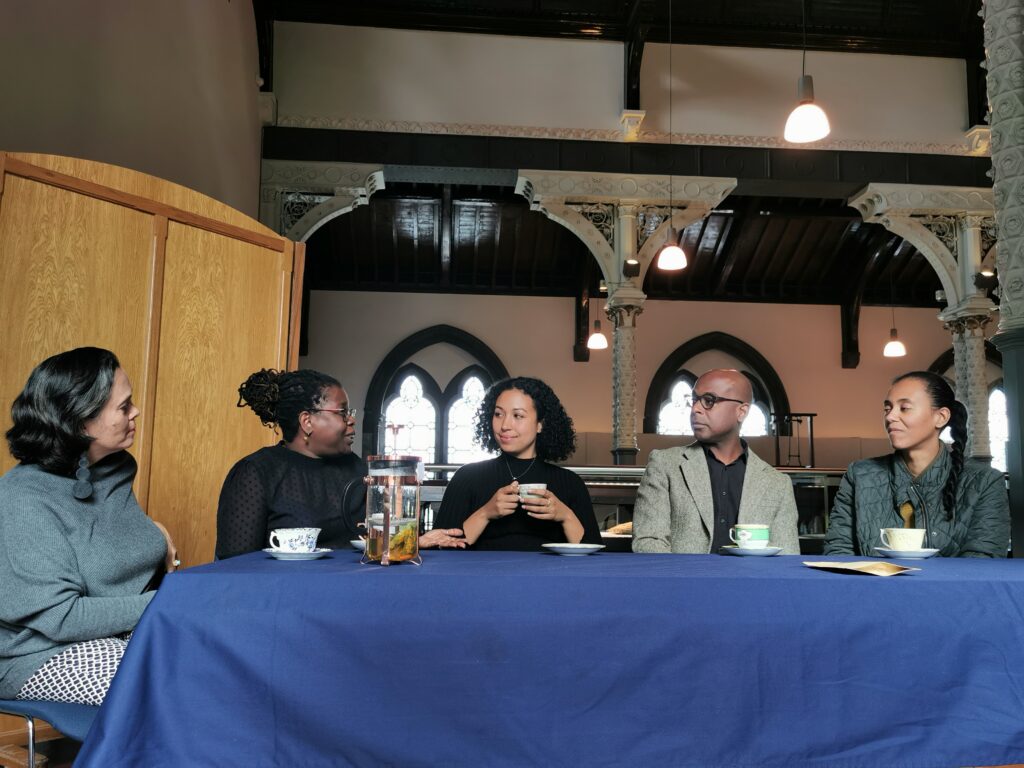
Unsweetened Conversations; Left to right: Annalee Davis, Dr. Peggy Brunache, Ashanti Harris and the Artisan Growers, Robert and Michelle Sullivan participating in Unsweetened Conversations. Photo by Caroline Gausden.
Planting ideas: sharing our work, inspirations and influences
We frequently use our website and social media platforms to highlight our green work at GWL. This includes both the work we’re doing to reduce our own carbon emissions and materials within our library and archive collections that the public can access to learn more about ecofeminism, climate change, climate justice and other issues relating to our relationship with the natural environment.
Volunteers have written and published book reviews as well as articles about gender and climate change, such as this great series created in the lead up to COP26. We have also shared a series of blog posts highlighting podcasts, articles and women who have inspired the Green Cluster. And two team members shared a fantastic Twitter thread exploring the power of science-fiction to imagine a greener world.
If you’d like to find out more about our green work or share yours with us, please get in touch.
